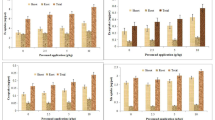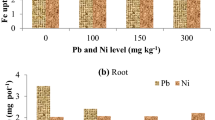Abstract
Direct discharge of waste into water bodies and mining are two major sources of lead contamination in ecosystems. Water scarcity promoted the usage of industrial effluent-contaminated waters for crop production, mainly in peri-urban areas. These wastewaters may contain heavy metals and pollute crop ecosystems. These metals can reach the living cell via contaminated raw foodstuffs that grow under these conditions and cause various ill effects in metabolic activities. In this study, graded levels of pressmud (0, 2.5, 5, 10 g/kg) were applied on lead imposed soil with different contamination levels (0, 100, 150, 300 mg/kg) and metal dynamics was studied in spinach crop. Experimental results showed that the addition of pressmud upto 10 mg/kg had decreased different phytoremediation indices in spinach crop. Whereas, increasing Pb level enhanced the indices’ values, indicating accumulation of significant amount of Pb in spinach biomass. However, application of pressmud (upto 10 mg/kg) reduced the bioconcentration factor (BCF) from 0.182 to 0.136, transfer factor (TF) from 0.221 to 0.191, translocation efficiency 66.11–59.34%; whereas, Pb removal enhanced from 0.063 to 0.072 over control treatment. These findings suggest that application of pressmud declined Pb concentration, the BCF and the TF in test crop which lead to less chances of adverse effect in human. These information are very useful for effectively managing wastewater irrigated agricultural crop production systems.

Similar content being viewed by others
Data Availability
All data generated or analysed during this study are included in this MS; publishing agency should have right to use for public domain. My manuscript has no associated data.
Abbreviations
- Pb:
-
Lead
- PM:
-
Pressmud
- DHA:
-
dehydrogenase activities
- TF:
-
Transfer factor
- BCF:
-
Bioconcentration factor
- TE:
-
Translocation efficiency
- EC:
-
Electrical conductivity
- OC:
-
Organic carbon
- CEC:
-
Cation exchange capacity
- ICP OES:
-
Inductively Coupled Plasma-Optical Emission Spectrometry
- ICAR:
-
Indian Council of Agricultural Research
- DTPA:
-
Diethylene triamine penta acetic acid
- DAS:
-
Days after sowing
- LSD:
-
Least significant difference
- CRD:
-
Complete randomized design
- ANOVA:
-
Analysis of variance
References
Adesodun JK, Atayese MO, Agbaje TA, Osadiaye BA, Mafe OF, Soretire AA (2010) Phytoremediation potentials of sunflowers (Tithonia diversifolia and Helianthus annus) for metals in soils contaminated with zinc and lead nitrates. Water Air Soil Pollu 207:195–201
Bouyoucos GJ (1963) Hydrometer method improved for making particle size analysis of soils. Agron J 54:464–465
Bunzl K, Albers BP, Schimmack W, Belli M, Ciuffo L, Menegon S (2000) Examination of a relationship between 137Cs concentrations in soils and plants from alpine pastures. J Environ Radioact 48:145–158
Collin S, Baskar A, Geevarghese DM, Ali MNVS, Bahubali P, Choudhary R, Lvov V, Tovar GI, Senatov F, Koppala S, Swamiappan S (2022) Bioaccumulation of lead and its effects in plants: a review. J Hazard Mat Lett 3:100064. https://doi.org/10.1016/j.hazl.2022.100064
Davis PA, Avadhanula MR, Cancio D, Carboneras P, Coughtrey P, Johansson G, Littleg RH, Smithg GM, Watkins BM (1999) BIOMOVS II: an international test of the performance of environmental transfer models. J Environ Radioact 42:117–1300
Dotaniya ML, Pipalde JS (2018) Soil enzymatic activities as influenced by lead and nickel concentrations in a Vertisol of Central India. Bull Environ Conta Toxic 101(3):380–385
Dotaniya ML, Meena VD, Rajendiran S, Coumar MV, Sahu A, Saha JK, Kundu S, Das H, Patra AK (2018) Impact of long-term application of Patranala sewage on carbon sequestration and heavy metal accumulation in soils. J Indian Soc Soil Sci 66(3):310–317
Dotaniya ML, Saha JK, Rajendiran S, Coumar MV, Meena VD, Das H, Kumar A, Patra AK (2019a) Reducing chromium uptake through application of calcium and sodium in spinach. Environ Monit Assess 191:754
Dotaniya ML, Saha JK, Rajendiran S, Coumar MV, Meena VD, Kundu S, Patra AK (2019b) Chromium toxicity mediated by application of chloride and sulphate ions in Vertisol of Central India. Environ Monit Assess 191:429
Dotaniya ML, Pipalde JS, Jain RC, Rajendiran S, Coumar MV, Saha JK, Patra AK (2019c) Can lead and nickel interaction affect plant nutrient uptake pattern in spinach (Spinacia oleracea)? Agric Res 9(3):358–364
Dotaniya ML, Rajendiran S, Meena VD, Coumar MV, Saha JK, Bhogal NS, Patra AK (2020) Comparative evaluation of phytoremediation potential of Indian mustard (Brassica juncea) varieties under sewage irrigated sites. J Indian Soc Soil Sci 68(4):450–457
Dotaniya ML, Meena VD, Saha JK, Dotaniya CK, Mahmoud AED, Meena BL, Meena MD, Sanwal RC, Meena RS, Doutaniya RK, Solanki P, Lata M, Rai PK (2022) Use of poor quality water for sustainable crop production in changing scenario of climate change. Environ Develop Sustain 24(4):31–52
Gomez KA, Gomez A (1983) Statistical procedures for agricultural research, 2nd edn. Wiley, New York
Gunjal A, Gunjal B (2021) Management of pressmud (agroindustry by–product) by conversion to value–added products: a review. Proc Indian Natl Sci Acad 87:11–18
Gupta N, Tripathi S, Balomajumder C (2011) Characterization of pressmud: a sugar industry waste. Fuel 90(1):389–394
Gupta RK, Panchal D, Pothabathul SV, Kushwaha PP, Maurya S, Kumar S (2019) Toxicity of heavy metals on health and their microbial remediation in environment. In: Mahdi AA, Abid M, Khan MM, Pandey SN (eds) Heavy metals toxicity in biological systems. Discovery Publishing House Pvt. Ltd., New Delhi (India), pp 180–193
Hanway JJ, Heidel H (1952) Soil analysis methods as used in Iowa state college soil testing laboratory. Iowa Agric 57:1–31
Imran M, Ashraf M, Awan AR (2021) Growth, yield and arsenic accumulation by wheat grown in a pressmud amended salt-affected soil irrigated with arsenic contaminated water. Ecotox Environl Saf 224:112692
Khan NK, Watanabe M, Watanabe Y (1999) Effect of different concentrations of urea with or without nickel addition on spinach (Spinacia oleracea E.) growth under hydroponic culture. Soil Sci Plant Nutr 45(3):569–575
Lin RZ, Wang XR, Luo Y, Du WC, Guo HY, Yin DQ (2007) Effects of soil cadmium on growth, oxidative stress and antioxidant system in wheat seedlings (Triticum aestivum L). Chemosph 69:89–98
Lindsay WL, Norvell WA (1978) Development of a DTPA soil test for zinc, iron, manganese and copper. Soil Sci Soc Am J 42:421–448
Meena AL, Jha P, Dotaniya ML, Kumar B, Meena BP, Jat RL (2019) Carbon, nitrogen, phosphorus mineralization as influenced by type of organic residues and soil contact variation in vertisol of central India. Agric Res 9:232–240
Meena MK, Singh AK, Prasad LK, Islam A, Meena MD, Dotaniya ML, Singh HV, Yadav BL (2020) Impact of arsenic-polluted groundwater on soil and produce quality: a food chain study. Environ Monit Assess 192:785
Meers E, Hopgood M, Lesage E, Vervaeke P, Tack FMG, Verloo M (2004) Enhanced phytoextraction: in search for EDTA alternatives. Intl J Phytore 6(2):95–109
Minhas PS, Saha JK, Dotaniya ML, Saha A, Saha M (2021) Wastewater irrigation in India: current status, impacts and response options. Sci Total Environ 808:1–17
Olsen SR, Cole CV, Watanabe FS, Dean LA (1954) Estimation of available phosphorus in soils by extraction with sodium bicarbonate. US Depart Agric Circ No. 939
Page AL, Miller RH, Keeney DR (1982) Methods of Soil Analysis. Part 2. Chemical and Microbiological Properties. American Society of Agronomy. In Soil Science Society of America, vol. 1159
Reeuwijk LP (2002) Procedures for soil analysis, vol 6th editionth. ISRIC, Wageningen. Technical paper no. 9
Saha JK, Rajendiran S, Coumar MV, Dotaniya ML, Kundu S, Patra AK (2017a) Soil pollution - an emerging threat to agriculture. Springer, Singapore
Saha JK, Rajendiran S, Coumar MV, Dotaniya ML, Kundu S, Patra AK (2017b) Assessment of heavy metals contamination in soil. in: soil pollution - an emerging threat to agriculture (Saha JK, Rajendiran S, Coumar MV, Dotaniya ML, Kundu S, Patra AK, Eds). Springer Singapore, pp 155–191. https://doi.org/10.1007/978-981-10-4274-7
Sheppard MI, Sheppard SC (1985) The plant concentration concept as applied to natural uranium. Health Phys 48:494–450
Singh D, Chhonkar PK, Dwivedi BS (2005) Manual on soil, plant and water analysis. Westville, New Delhi
Stasinakis AS, Thomaidis NS, Lekkas TD (2002) Speciation of chromium in wastewater and sludge by extraction with liquid anion exchanger Amberlite LA-2 and electrothermal atomic absorption spectrometry. Anal Chim Acta 478:119e127
Subbiah BV, Asija GL (1956) A rapid procedure for the determination of available nitrogen in soils. Curr Sci 25:259–260
Walkley AJ, Black IA (1934) An examination of the Degtjaff method for determining soil organic matter and a proposed modification of the chromic acid titration method. Soil Sci 37:29–38
Wan Y, Devereux R, George RE, Chen J, Gao B, Noerpel M, Scheckel K (2022) Interactive effects of biochar amendment and lead toxicity on soil microbial community. J Hazard Mater 425:127921
Zhuang P, Yang QW, Wang HB, Shu WS (2007) Phytoextraction of heavy metals by eight plant species in the field. Water Air Soil Pollu 184:235–242
Author information
Authors and Affiliations
Corresponding authors
Ethics declarations
Conflict of Interest
The authors declare that they have no conflict of interest.
Additional information
Publisher’s Note
Springer Nature remains neutral with regard to jurisdictional claims in published maps and institutional affiliations.
Rights and permissions
Springer Nature or its licensor (e.g. a society or other partner) holds exclusive rights to this article under a publishing agreement with the author(s) or other rightsholder(s); author self-archiving of the accepted manuscript version of this article is solely governed by the terms of such publishing agreement and applicable law.
About this article
Cite this article
Dotaniya, M.L., Nagar, M.C., Sharma, A. et al. Pressmud Subdue Phytoremediation Indices in Lead-Contaminated Soils: A Human Health Perspective. Bull Environ Contam Toxicol 112, 16 (2024). https://doi.org/10.1007/s00128-023-03848-9
Received:
Accepted:
Published:
DOI: https://doi.org/10.1007/s00128-023-03848-9




